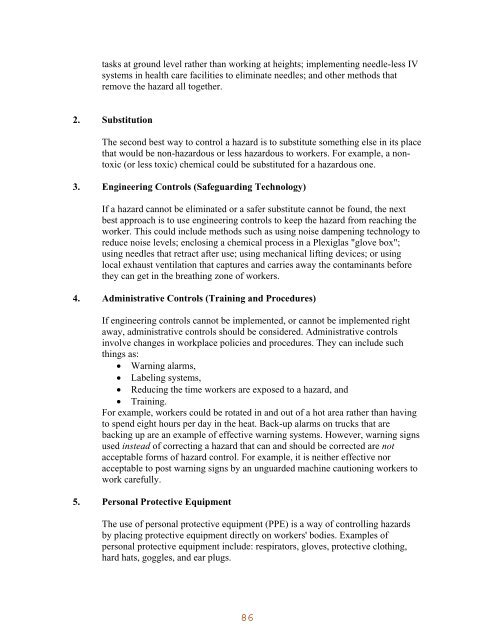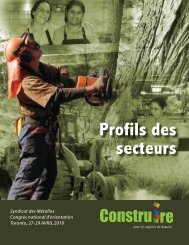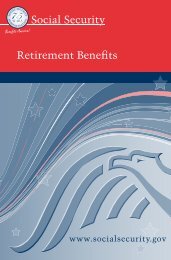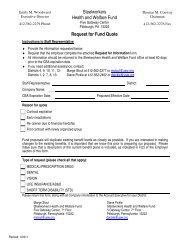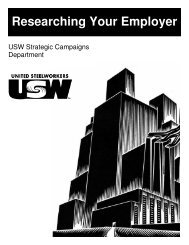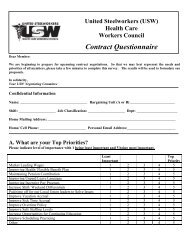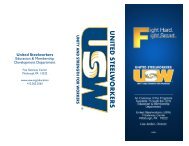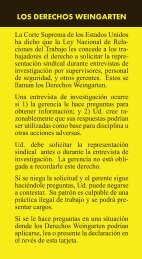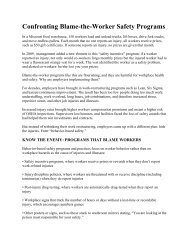Union Approach to Health and Safety: - United Steelworkers
Union Approach to Health and Safety: - United Steelworkers
Union Approach to Health and Safety: - United Steelworkers
Create successful ePaper yourself
Turn your PDF publications into a flip-book with our unique Google optimized e-Paper software.
tasks at ground level rather than working at heights; implementing needle-less IV<br />
systems in health care facilities <strong>to</strong> eliminate needles; <strong>and</strong> other methods that<br />
remove the hazard all <strong>to</strong>gether.<br />
2. Substitution<br />
The second best way <strong>to</strong> control a hazard is <strong>to</strong> substitute something else in its place<br />
that would be non-hazardous or less hazardous <strong>to</strong> workers. For example, a non<strong>to</strong>xic<br />
(or less <strong>to</strong>xic) chemical could be substituted for a hazardous one.<br />
3. Engineering Controls (Safeguarding Technology)<br />
If a hazard cannot be eliminated or a safer substitute cannot be found, the next<br />
best approach is <strong>to</strong> use engineering controls <strong>to</strong> keep the hazard from reaching the<br />
worker. This could include methods such as using noise dampening technology <strong>to</strong><br />
reduce noise levels; enclosing a chemical process in a Plexiglas "glove box";<br />
using needles that retract after use; using mechanical lifting devices; or using<br />
local exhaust ventilation that captures <strong>and</strong> carries away the contaminants before<br />
they can get in the breathing zone of workers.<br />
4. Administrative Controls (Training <strong>and</strong> Procedures)<br />
If engineering controls cannot be implemented, or cannot be implemented right<br />
away, administrative controls should be considered. Administrative controls<br />
involve changes in workplace policies <strong>and</strong> procedures. They can include such<br />
things as:<br />
Warning alarms,<br />
Labeling systems,<br />
Reducing the time workers are exposed <strong>to</strong> a hazard, <strong>and</strong><br />
Training.<br />
For example, workers could be rotated in <strong>and</strong> out of a hot area rather than having<br />
<strong>to</strong> spend eight hours per day in the heat. Back-up alarms on trucks that are<br />
backing up are an example of effective warning systems. However, warning signs<br />
used instead of correcting a hazard that can <strong>and</strong> should be corrected are not<br />
acceptable forms of hazard control. For example, it is neither effective nor<br />
acceptable <strong>to</strong> post warning signs by an unguarded machine cautioning workers <strong>to</strong><br />
work carefully.<br />
5. Personal Protective Equipment<br />
The use of personal protective equipment (PPE) is a way of controlling hazards<br />
by placing protective equipment directly on workers' bodies. Examples of<br />
personal protective equipment include: respira<strong>to</strong>rs, gloves, protective clothing,<br />
hard hats, goggles, <strong>and</strong> ear plugs.


